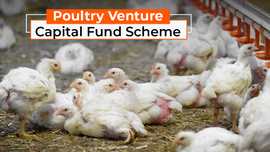List of Government Schemes for Dairy Farming in India

The dairy sector is the most important sub-sector of agriculture, which provides employment to millions in India and contributes significantly to the overall economy. The government has been supporting the dairy development in India through launching various schemes. Their objectives range from the promotion of entrepreneurship and modernisation of infrastructure to the conservation of indigenous cattle breeds.
Table of Contents
- Overview of the Dairy Sector
- Central Government Schemes for Dairy Farming
- State Government Schemes for Dairy Farming
Overview of the Dairy Sector
Dairy contributes 5% to India’s national income, making it the largest agricultural commodity. Also, it gives direct employment to over 8 crore farmers. Milk production in India stands at 239.3 million tonnes annually. In 2022, the worth of the packaged dairy products market was noted to be INR 3 lakh crore.
Dairy products are mainly produced in Uttar Pradesh, Rajasthan, Punjab, Madhya Pradesh, and Himachal Pradesh. Also, the key players in this industry are Kwality Limited, Aavin, Dudhsagar Dairy, Orissa State Cooperative Milk Producers Federation, Mother Dairy and Amul.
Central Government Schemes for Dairy Farming
The Indian government considers dairy a high-priority sector because of its socio-economic importance. Thus, the government is committed to dairy development in India. For this purpose, it is actively boosting developments across the sector via the introduction of various programs and schemes. Let us explore some major government schemes for dairy farming in India.
Rashtriya Gokul Mission (RGM)
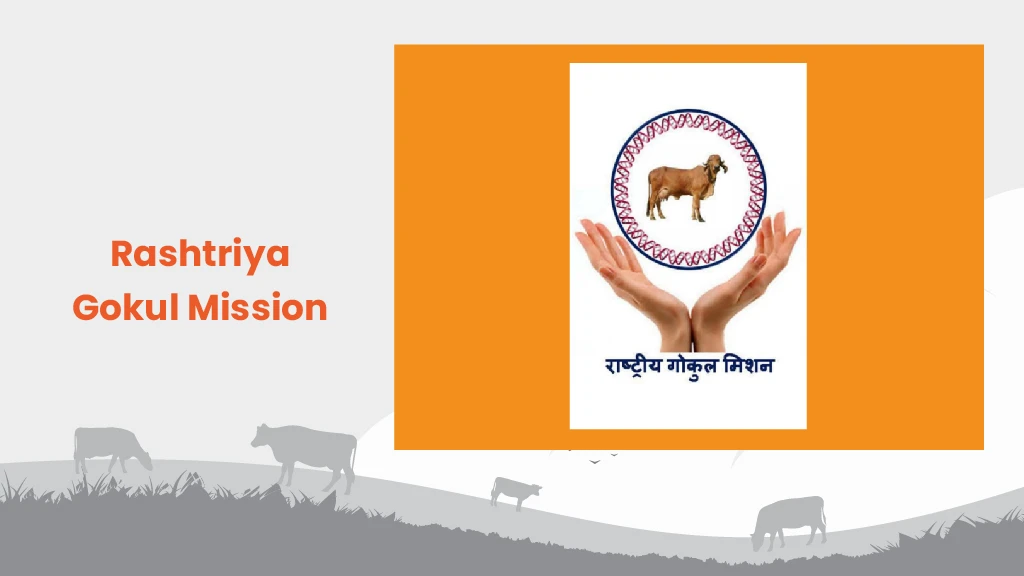
Rashtriya Gokul Mission was implemented in Dec 2014 aims to enhance milk output and productivity through enhancing the bovine's productivity. The programme seeks to achieve the goal through following:
- Making High genetic Merit Germplasm available
- Extending the Artificial Insemination Network
- Develop and conserve indigenous breeds
- Innovation and R&D in Bovine Breeding
National Programme for Dairy Development (NPDD)
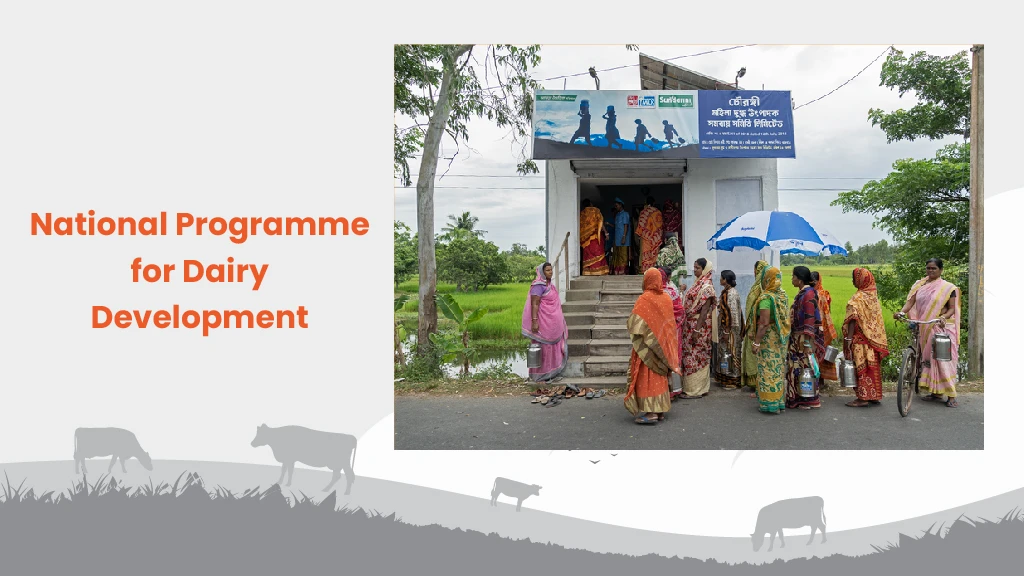
NPDD was implemented in Feb 2014 to strengthen infrastructure and produce high-quality milk. It also assists the State Cooperative Dairy Federation or State Implementing Agency in procuring, processing and marketing milk and its products. The National Programme for Dairy Development scheme was restructured and realigned in July 2021.
The redesigned NPDD has been implemented for a period of 2021-22 to 2025-26. Its budget has been set at INR 1,790 crores. Its objective is to improve the quality of milk and its products along with enhancement in organised milk procurement.
This scheme offers farmers training in relation to good manufacturing practices and good hygienic practices. They are educated in several aspects, including mineral mixture, green fodder, adoption of cattle feed, milch animal rearing and clean milk production.
Dairy Processing and Infrastructure Development Fund (DIDF)
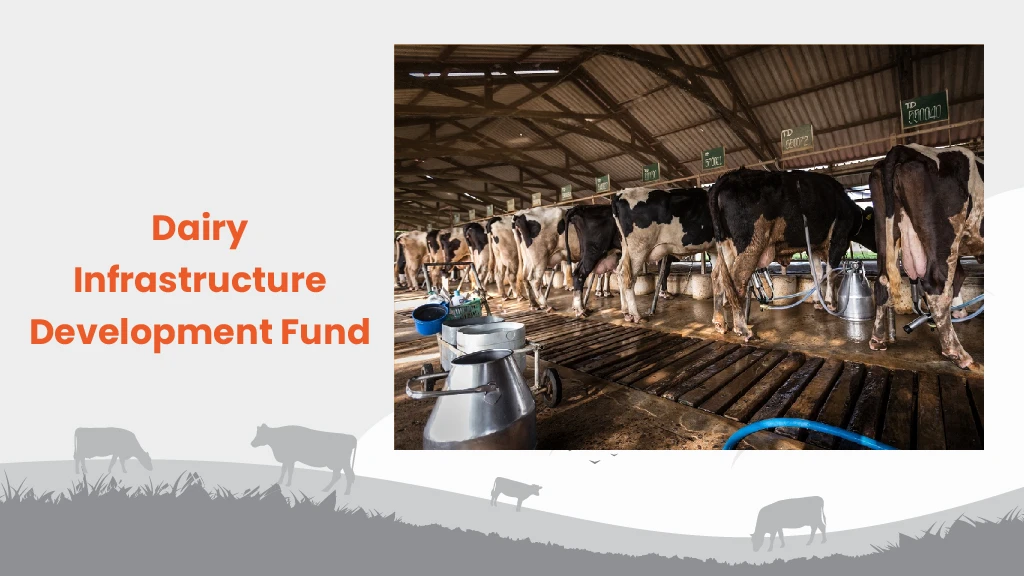
The Indian government created DIDF with a total outlay of INR 11,184 crore for the period of 2018-19 to 2022-23. This scheme offers loan assistance to Eligible End Borrowers (EEBs) like Multi State Cooperatives, Milk Producers Companies, District Milk Unions, State Dairy Federations and NDDB subsidiaries nationwide.
The repayment period of loans is set to be extended up to 2030-31. The objective of the DIDF is the modernisation of milk processing plants and machinery. Also, additional infrastructure is being financed to process more milk.
DIDF has helped increase direct and indirect employment opportunities for unskilled, skilled and semi-skilled workers. Several project activities are covered by this dairy loan scheme, including expanding and modernising milk processing facilities, establishing bulk milk coolers (BMCs), manufacturing facilities for value-added products, and opening new processing plants.
Animal Husbandry Infrastructure Development Fund (AHIDF)
AHIDF has been introduced with a corpus of INR 15,000 crore to increase investments in infrastructure related to dairy processing. It involves incentives for a range of players like FPOs, MSMEs, private companies and individual entrepreneurs. The scheme was extended up to 2025-26 under the Infrastructure Development Fund with a budget of INR 29,610.25 crore. Since its introduction, AHIDF has increased the milk processing capacity by 141.04 lakh litre per day (LLPD).
National Livestock Mission (NLM)
National Livestock Mission was started in 2014-15 to develop entrepreneurship to establish cattle breeding projects. Under this scheme, you can get a 50% capital subsidy (up to INR 2 crore) to establish entrepreneurship related to dairy cow farming and dairy buffalo farming.
Farmers, cooperatives, and other stakeholders in the dairy sector can use government schemes for dairy farming to improve their infrastructure and increase their income. The government is working towards a prosperous future for the dairy sector, and everyone involved in it.
Kisan Credit Card (KCC) Scheme
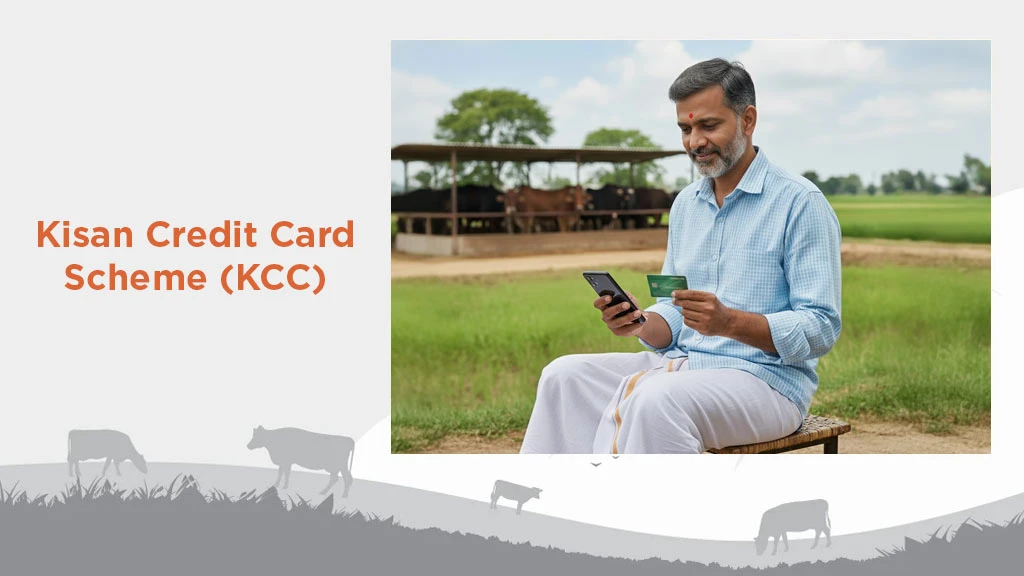
The Government of India in 2020 extended the Kisan Credit Card Scheme to farmers engaged in animal husbandry, including dairy. Under the scheme, the government has undertaken initiative to provide KCC to 1.5 crore dairy farmers belonging to Milk producing companies and Milk Unions.
State Government Schemes for Dairy Farming
Here are some state-level dairy farming schemes across India:
Haryana
- Scheme for Conservation and Development of Indigenous Cattle and Murrah Development (2025-2026): This scheme is implemented by the department in the state with the objective of conservation and development of the breeds of Indigenous cows and buffaloas. The goal is to encourage farmers to rear and breed high yielding animals which inturn could help increase the overall milk production.
- Scheme for Establishment of Hi-Tech and Mini Dairy Units (2025-2026): This scheme targets women farmers and unemployed youth by promoting dairy units for self-employment and enhanced milk production. The goal of this scheme is to promote self-employment among women farmers, enhance milk and dairy product output and Support commercialization of dairy units.
Uttar Pradesh
- Mukhayamantri Swadesh Gau Samvardhan Yojana (2024-2025): The Mukhayamantri Swadesh Gau Samvardhan Yojana launched under the Nand Baba Milk Mission in Uttar Pradesh, aims to promote indigenous cow breeds by providing financial assistance to eligible beneficiaries. Under this scheme farmers can receive a subsidy of up to INR 80,000 (covering up 40% of the cost) for setting up a unit with two indigenous milch cows, such as Sahiwal Tharparkar and Harayana breeds. The scheme is being implemented across 57 districts of the state, with priority being given to women and individuals from SC/ST and backward classes.
- Nandini Krishak Samriddhi Yojana: Under the Nandini Krishak Samriddhi Yojana, farmers will be provided with resources for selling milk and receive fair prices for their milk. Dairy cooperative societies will help facilitate arrangements for livestock owners to sell milk within their own villages. Along with farmers, subsidies will also be provided to those involved in producing animal feed and fodder to encourage their growth. A total subsidy of 50% of the project cost will be provided.
Chattisgarh
- Godhan Nyay Yojana: The Godhan Nyay Yojana was introduced by Chattisgarh government with the goal of promoting organic farming, generating new employment opportunities in rural and urban areas, promoting cow rearing and providing financial benefits to cattle owners. Under this scheme, government would buy cow dung from farmers and animal raisers at 2 rupees per kg. The Women Self-Help Group turns cow waste into vermicompost, which are then sold to farmers as organic manure for ₹8 per kilogramme.
Kerala
- Milk Shed Development Program: The project aims to help dairy farmers in Kerala state establish dairy farming as a primary source of income as well as improve milk production. It encourages farmers to take up Dairying as a primary occupation and adopting scientific management practices in cattle farming. It also helps provide self-employment opportunities as well as livelihood for the rural youth and women community and works as a tool for “Extreme Poverty Alleviation”.
Other State Dairy Schemes
- Chief Minister Kamadhenu Scheme (Odisha)
- Balasaheb Thackeray Agribusiness & Rural Transformation (SMART) Project
- Kamdhenu Niwas – 2025 (Madhya Pradesh)
- Medha Dairy Infrastructure (Jharkhand)
Frequently Asked Questions On List of Government Schemes for Dairy Farming in India
1. What is the subsidy for dairy farming?
Subsidy is the government's financial assistance that helps dairy farmers and organisations establish and grow their businesses. For example, a 50% capex subsidy with a ceiling of INR 2 crores is available for breed multiplication farms.
2. What is dairy farm scheme 2024?
In Budget 2024, the Finance Minister of India focused on robust dairy development with a 3% interest subvention for dairy cooperatives to modernise their plants
3. What is NABARD subsidy for dairy farming?
For setting up dairy units, NABARD offers a subsidy of 25% of outlay and 33.33% of outlay for general people and SC/ST, respectively.
4. Is dairy farming tax free?
No, dairy farming is not tax-free.
5. Can I get Mudra loan for dairy farming?
Yes, you can get credit up to ₹10 lakh under the Pradhan Mantri MUDRA Yojana scheme for dairy farming.


Related Blogs



